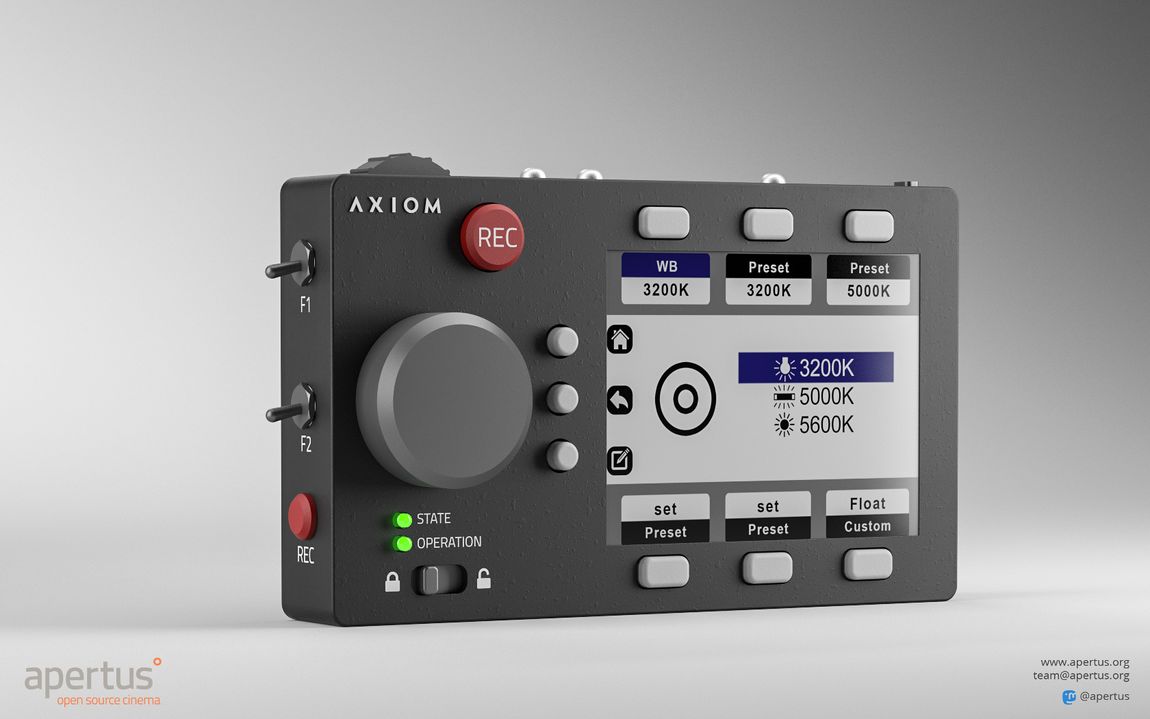Difference between revisions of "AXIOM Remote"
(→Status) |
|||
| Line 74: | Line 74: | ||
| 2x Rotary Knobs (infinite rotation) || additional slider/fader knob || Force Feedback Rotary Knobs (built-in microstepper motor) | | 2x Rotary Knobs (infinite rotation) || additional slider/fader knob || Force Feedback Rotary Knobs (built-in microstepper motor) | ||
|} | |} | ||
==General Concept== | ==General Concept== | ||
Revision as of 14:50, 18 November 2018
1 Overviews |
2 Technical |
3 Resources |
|
|
AXIOM Remote Concept Rendering 2018 - Note: Design is subject to change as improvements are made.
4 Project Overview
This device, and its associated software, is designed to be a comprehensive remote control unit for the AXIOM Beta range of cameras. Like the devices it controls, AXIOM Remote is an open source, open hardware project and all data surrounding its research and development shall be made freely available.
Note: The concepts on this page are pre-production and thereby subject to change as improvements are made. Please do get involved with either ideas for future PCB/enclosure revisions or programming software related to GUI (general user interface).
AXIOM Remote was funded as a stretch goal in the AXIOM Beta crowd funding campaign. It features push-buttons and switches as well as 2 rotary encoders (also with push-button function) that can be used to control a wide range of camera parameters like shutter speed, gain, overlays, FPS, gamma curves etc. To keep everything as flexible as possible the buttons next to the LCD have dynamic functionality as their commands are displayed next to them on the LCD. Switches on the side allow locking of each individual dial wheel or all the buttons together.
Force Feedback for the two dials with two small built-in micro-stepper motors allowing for feeling settings (e.g. min, max reached) without users having to look at the display was considered but deemed too complex/expensive for time-being.
The AXIOM Remote is based on a 2.8" LCD screen (showing status information, camera parameters and enabling navigation through menus) and a PIC32MZ micro-controller. The connection between AXIOM Remote and an AXIOM camera will be a flexible (preferably spiral) cable with solid connectors. Expansion slots (with GPIO) will make future additions of new buttons/knobs/wheels/controllers/interfaces easy and straight forward.
- Source on GitHub can be found here. It contains a project that can be opened in MPLABX (note that the XC32 compiler is a separate download). The software runs bare metal on the PIC32MZ.
- Workboard in apertus° Labs can be found here.
| Essentials | Good to Have | Luxury |
|---|---|---|
| a few Status LEDs | single color LED under most buttons (transparent) | RGB LED under every button (transparent) |
| power supply from camera | power IN connector | own battery mount |
| wired operation | wireless operation option | |
| turn LCD into touchscreen (can be disabled in menu) | ||
| Control all AXIOM related functionalists | Control active lens mount related functionalists | Remote Control other cameras and devices (LANC, USB, DSLR Shutter Release, etc.) |
| 2x Rotary Knobs (infinite rotation) | additional slider/fader knob | Force Feedback Rotary Knobs (built-in microstepper motor) |
5 General Concept
File:AXIOM Remote V3 ButtonPos.pdf
6 Enclosure
The plan is to design a two part assembly of aluminium CNC milled front/back that are screwed together.
Ongoing OnShape CAD design: https://cad.onshape.com/documents/f41e9dcb61a8767f69b714af/w/009161441d6a06c023fb1540/e/982232b9f340d1f56d459ba2
CAD Todos:
- design silicone rubber (or alternatively solid plastic single button) pads for buttons
- design extension module mount (right side) and electronics connectors
- design connector position
- test TFT in direct sunlight, consider options for shading screen on remote somehow.
- Herbert suggested instead of screwing the PCB it could be clamped between front/back, he will share photos of this concept in action.
7 Camera Menu Simulators for Reference
Our very own very early stage menu simulator: [1] and its source code: [2]
We do not want to copy but we do want to learn from the experience and mistake of others, also a kind of standard has established itself with the way professional cinema cameras are operated:
Arri product line: [3]
Panasonic Varicam: [4]
Sony Venice: [5]
8 Further Notes, References, Collected Links
- http://marekburiak.github.io/ILI9341_due/ graphics library using the same display driver as the 2.8" Adafruit TFT
- https://github.com/rxi/map
